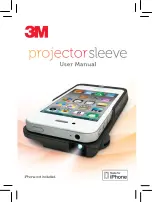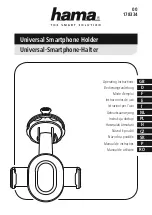
3.10. External memory interface
The MSM6280 device was designed to provide two distinct memory interfaces. EBI1 was targeted for
supporting high speed synchronous memory devices. EBI2 was targeted towards supporting slower
asynchronous devices such as LCD, NAND flash, SRAM, etc. In addition, MSM6280 provide SD bus
interface. U970/KU970 supports 512MByte free user memory using SD interface.
• EBI1 Features
- 16 bit static and dynamic memory interface
- 32 bit dynamic memory interface
- 24 bits of address for static memory devices which can support up to 32MBytes on each chip select
- Synchronous burst memories supported (burst NOR, burst PSRAM)
- Synchronous DRAM memories supported
- Byte addressable memory supporting 8 bit, 16 bit and 32 bit accesses
- Pseudo SRAM (PSRAM) memory support
• EBI2 Features
- Support for asynchronous FLASH and SRAM(16bit & 8bit).
- Interface support for byte addressable 16bit devices (UB_N & LB_N signals).
- 2Mbytes of memory per chip select.
- Support for 8 bit/16bit wide NAND flash.
- Support for parallel LCD interfaces, port mapped of memory mapped(18 or 16 bit).
• 1Gb NAND(8bit) flash 512Mb SDRAM (32bit)
+ 512MB NAND flash memory( 4 bit SD interface )
• 1-CS(Chip Select) are used.
• The SD bus allows the dynamic configuration of the number of data line from 1 to 4 Bidirectional data
signal. After power up by default, the Device will use only DAT0. After initialization, host can change
the bus width.
3. TECHNICAL BRIEF
- 50 -
Interface Spec
Device
Part Name
Maker
Read Access Time
Write Access Time
FLASH
TY9C00A800AUGK
Toshiba
50 ns
50 ns
SDRAM
TY9C00A800AUGK
Toshiba
15 ns
15 ns
Table#1. External memory interface
Summary of Contents for U970
Page 1: ...Date April 2007 Issue 1 0 Service Manual Model U970 KU970 Service Manual U970 KU970 ...
Page 3: ... 4 ...
Page 20: ...3 TECHNICAL BRIEF 21 Fig 1 2 RTR6275 RX feature ...
Page 28: ...3 TECHNICAL BRIEF 29 Figure1 7 PM6650 Block Diagram ...
Page 41: ...3 TECHNICAL BRIEF 42 Table 1 1 Summary of MSM6280 device features ...
Page 45: ...3 TECHNICAL BRIEF 46 Figure 1 1 PM6650 Functional Block Diagram ...
Page 76: ...4 TROUBLE SHOOTING 77 4 1 RF CRF Component TOP SIDE BOTTOM SIDE 4 TROUBLE SHOOTING ...
Page 81: ...4 TROUBLE SHOOTING 82 Check C412 of PMIC U400 Check R214 of MSM U200 ...
Page 83: ...4 TROUBLE SHOOTING 84 Logic Table of the FEM ...
Page 89: ...4 TROUBLE SHOOTING 90 4 7 Checking GSM Block ...
Page 91: ...4 7 3 Checking RF Tx level 4 TROUBLE SHOOTING 92 ...
Page 94: ...4 TROUBLE SHOOTING 95 ...
Page 100: ...4 TROUBLE SHOOTING 101 R403 Q402 Q401 Q400 Charging part Main PCB Front ...
Page 103: ...4 TROUBLE SHOOTING 104 Q400 X 200 USB part 1 Main PCB Front U503 USB part 2 Main PCB Rear ...
Page 112: ...4 TROUBLE SHOOTING 113 CN601 CN701 CN700 ...
Page 115: ...4 TROUBLE SHOOTING 116 C500 C501 R501 R502 ...
Page 117: ...4 TROUBLE SHOOTING 118 SPK Audio Amplifier Analog Switch ...
Page 119: ...4 TROUBLE SHOOTING 120 MIC800 R507 C520 ...
Page 121: ...4 TROUBLE SHOOTING 122 R303 Ear_Sense_N C210 MIC Input ...
Page 141: ...5 DOWNLOAD 142 ...
Page 147: ...5 DOWNLOAD 148 Read IMEI BT address from UE 2 Step 4 Check IMEI and Bluetooth address ...
Page 158: ...6 BLOCK DIAGRAM 159 Table 2 1 RF Block Component ...
Page 163: ...6 BLOCK DIAGRAM 164 6 2 4 Placement Top Side ...
Page 164: ...6 BLOCK DIAGRAM 165 Bottom Side ...
Page 165: ... 166 ...
Page 175: ... 176 8 PCB LAYOUT U970 KU970 ...
Page 176: ... 177 8 PCB LAYOUT U970 KU970 ...
Page 177: ... 178 8 PCB LAYOUT U970 KU970 ...
Page 178: ... 179 8 PCB LAYOUT U970 KU970 ...
Page 179: ... 180 8 PCB LAYOUT ...
Page 180: ... 181 8 PCB LAYOUT ...
Page 181: ... 182 ...
Page 187: ... 188 ...
Page 189: ... 190 ...
Page 209: ...Note ...
Page 210: ...Note ...
















































